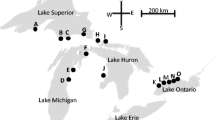Abstract
Adult sea lampreys locate spawning streams in the Great Lakes by using a migratory pheromone that is released by stream-resident larval conspecifics. Behavioral, electrophysiological, and biochemical analyses of larval release water have suggested that this pheromone is composed of several components, one of which is petromyzonol sulfate (PS), a known lamprey-specific bile acid. Its precursor, allocholic acid (ACA), has also been implicated. In this study, we employed high-performance liquid chromatography and mass spectrometry to look for both bile acids in various stream waters, thereby testing whether they might have a role in natural pheromone function. Although PS was measured at picomolar concentrations in streams known to contain larval lampreys and attract migratory adults, ACA was not. Neither compound was measured in streams lacking larvae. This finding indicates that PS is a component of the natural pheromone, and it suggests that ACA has little relevance.

Similar content being viewed by others
References
R. Bjerselius W. Li J. H. Teeter J. G. Seelye P. B. Johnsen P. J. Maniak G. C. Grant A. N. Polkinghorne P. W. Sorensen (2000) ArticleTitleDirect evidence that unique bile acids released by larval sea lamprey function as a migratory pheromone Can. J. Fish. Aquat. Sci. 57 557–569 Occurrence Handle10.1139/cjfas-57-3-557
J. M. Fine L. A. Vrieze P. W. Sorensen (2004) ArticleTitleEvidence that Petromyzontid lampreys employ a common migratory pheromone that is partially comprised of bile acids J. Chem. Ecol. 30 2091–2110 Occurrence Handle10.1023/B:JOEC.0000048776.16091.b1 Occurrence Handle15672658
W. Li P. W. Sorensen D. D. Gallaher (1995) ArticleTitleThe olfactory system of migratory adult sea lamprey is acutely and specifically sensitive to unique bile acids released by conspecific larvae J. Gen. Physiol. 105 569–587 Occurrence Handle10.1085/jgp.105.5.569 Occurrence Handle7658193
C. N. Polkinghorne J. M. Olson D. D. Gallaher P. W. Sorensen (2001) ArticleTitleLarval sea lamprey release two unique bile acids to the water at a sufficient rate to produce a detectable pheromonal plume Fish Physiol. Biochem. 24 15–30 Occurrence Handle10.1023/A:1011159313239
L. P. Schleen G. T. Klar (2000) Integrated Management of Sea Lampreys in the Great Lakes 1999: Annual Report to the Great Lakes Fishery Commission Great Lakes Fishery Commission Ann Arbor, MI
L. P. Schleen G. T. Klar (2002) Integrated Management of Sea Lampreys in the Great Lakes 2001: Annual Report to the Great Lakes Fishery Commission Great Lakes Fishery Commission Ann Arbor, MI
P. W. Sorensen L. A. Vrieze (2003) ArticleTitleRecent progress understanding the chemical ecology and potential application of the sea lamprey migratory pheromone J. Great Lakes Res. 29 IssueIDSupplement 1 66–84
P. W. Sorensen L. A. Vrieze J. M. Fine (2003) ArticleTitleA multi-component migratory pheromone in the sea lamprey Fish Physiol. Biochem. 28 253–257 Occurrence Handle10.1023/B:FISH.0000030545.39156.2b
M. B. Twohey P. W. Sorensen W. Li (2003) ArticleTitlePossible applications of pheromones in an integrated sea lamprey management program J. Great Lakes Res. 29 IssueIDSupplement 1 794–800
L. A. Vrieze P. W. Sorensen (2001) ArticleTitleLaboratory assessment of the role of a larval pheromone and natural stream odor in spawning stream localization by migratory sea lamprey (Petromyzon marinus) Can. J. Fish. Aquat. Sci. 58 2374–2385 Occurrence Handle10.1139/cjfas-58-12-2374
Acknowledgments
Lance Vrieze (University of Minnesota), Roger Bergstedt and Jeff Locke (United States Geological Survey), and Doug Cuddy (Fisheries and Oceans Canada) collected river waters. Jeff Slade (United States Fish and Wildlife Service) provided estimates of larval abundance for some of the rivers. Thanks also to Thomas Krick and Leeann Higgins of the Mass Spectrometry Consortium for the Life Sciences at the University of Minnesota. Funding was provided by the Great Lakes Fishery Commission.
Author information
Authors and Affiliations
Corresponding author
Rights and permissions
About this article
Cite this article
Fine, J.M., Sorensen, P.W. Biologically Relevant Concentrations of Petromyzonol Sulfate, a Component of the Sea Lamprey Migratory Pheromone, Measured in Stream Water. J Chem Ecol 31, 2205–2210 (2005). https://doi.org/10.1007/s10886-005-6745-4
Received:
Revised:
Published:
Issue Date:
DOI: https://doi.org/10.1007/s10886-005-6745-4




